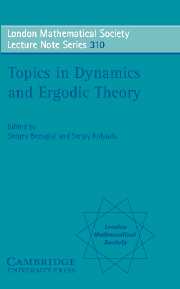Book contents
- Frontmatter
- Contents
- Preface
- Alexeyev's photo
- Introductory talk at the opening of the conference
- Minimal idempotents and ergodic Ramsey theory
- Symbolic dynamics and topological models in dimensions 1 and 2
- Markov odometers
- Geometric proofs of Mather's connecting and accelerating theorems
- Structural stability in one dimensional dynamics
- Periodic points of nonexpansive maps: a survey
- Arithmetic dynamics
- The defect of factor maps and finite equivalence of dynamical systems
- Actions of amenable groups
Symbolic dynamics and topological models in dimensions 1 and 2
Published online by Cambridge University Press: 18 August 2009
- Frontmatter
- Contents
- Preface
- Alexeyev's photo
- Introductory talk at the opening of the conference
- Minimal idempotents and ergodic Ramsey theory
- Symbolic dynamics and topological models in dimensions 1 and 2
- Markov odometers
- Geometric proofs of Mather's connecting and accelerating theorems
- Structural stability in one dimensional dynamics
- Periodic points of nonexpansive maps: a survey
- Arithmetic dynamics
- The defect of factor maps and finite equivalence of dynamical systems
- Actions of amenable groups
Summary
INTRODUCTION
Symbolic dynamics has a long and distinguished history, going back to Hadamard's work on the geodesic flow on negatively curved surfaces. Because of its success in describing the dynamics of systems with Markov partitions, it is most closely associated with the study of such systems. However, in the 1970's, beginning with the work of Metropolis, Stein and Stein and culminating with the kneading theory of Milnor and Thurston, symbolic dynamics was used in a quite different way in the study of 1-dimensional discrete dynamics: the partition was fixed (given by the critical points) and the maps were allowed to vary in families, as long as the critical points remained the same. This is fundamentally different from the use of symbolic dynamics in the presence of Markov partitions. Not only does it not require the maps being studied to have such partitions, but also, by fixing the partition, it permits the description of all maps in a family in terms of the same symbols, thus allowing the comparison of different maps.
One of the conclusions of kneading theory is that every family of unimodal maps (i.e. continuous piecewise monotone self-maps of the unit interval with exactly two monotone pieces) presents essentially the same dynamical behaviour as it passes from trivial to chaotic dynamics.
- Type
- Chapter
- Information
- Topics in Dynamics and Ergodic Theory , pp. 40 - 59Publisher: Cambridge University PressPrint publication year: 2003
- 2
- Cited by



